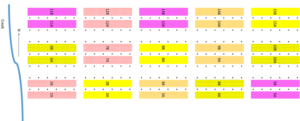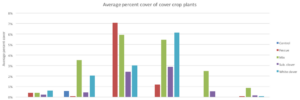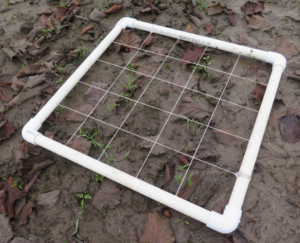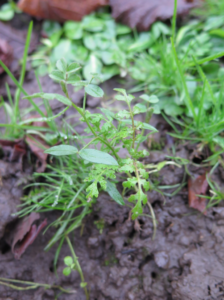2016 Annual Report for OW16-028
Evaluating cover crops for mature hazelnut orchards in the Willamette Valley, Oregon
Summary
The purpose of this project is to examine potential benefits of winter cover crops for mature hazelnut orchards in the Willamette Valley, Oregon where 99% of the US hazelnut crop is produced. Currently, maintenance of a bare orchard floor is the common practice and erosion and nutrient leaching are major concerns during the wet winter season. We have used to project to develop collaborations with a number of organizations with interest in soil conservation or promoting benefits of cover crops. We met or exceeded performance targets for the first year (2016) with the exception that we are still gathering background information on the producer orchards where the plots are located. Despite weather setbacks we were able to seed more plots (6) than we had originally proposed. Other products include outreach at a cover crop workshop, cover crop menus that were disseminated to growers at the workshop and Extension presentations that discussed the project.
Objectives/Performance Targets
- Select candidate cover crop species using producer input.
- Lay out cover crop research plots in mature orchards.
- Collect historic and current baseline data on test plots for yield history, soil quality, erosion and canopy cover.
- Coordinate seed purchase and seed drill rental.
- Seed 1 acre of each of 4 seed treatments and controls (unseeded, bare ground) into replicated test plots in randomized block design at each cooperating producer orchard.
Accomplishments/Milestones
Objective 1. Select candidate cover crops with producer input. In selecting our candidate cover crops we reached out to multiple specialty seed producers in the Willamette Valley to solicit opinions and knowledge. We also met with the USDA-NRCS Corvallis Plant Materials Center to benefit from their experience with cover crops. We held a cover crop workshop and grower panel at the Oregon State University North Willamette Research and Extension Center (NWREC) in Aurora on June 2, 2016 (Figure 1). The workshop attracted approximately 35 growers. In the workshop we had presentations from representatives of both the Clackamas and Yamhill County Soil and Water Conservation Districts, who discussed cover crop options for hazelnut orchards and how cover crop plantings could fit in with NRCS conservation incentive programs (EQIP). We also had a grower panel where growers discussed their experience with different cover crops in orch

ards. The final cover crop selections were determined at a separate planning meeting with the producers cooperating on this grant. We selected the following cover crops for the first year: subterranean clover (28 lbs/acre), white clover (15 lbs/acre), creeping red fescue (35 lbs/acre), and a mix consisting of phacelia (15%), vetch (15%) and triticale (50%; 83 lbs/acre). All cover crops were locally sourced. The untreated control blocks were not seeded but volunteer cover crops may be present (mainly Poa spp.).
Objective 2. Lay out cover crop research plots in mature orchards. We used a randomized complete block design to plant the same cover crop blocks at each orchard. The R statistical environment was used to generate treatment randomizations. Orchards had tree and alley spacings from 9 ´18 ft (double density) to 20 ´ 20 ft (single density), and treatment block sizes ranged from 99-100 ft between sites as a result. In double density plantings there were 11 trees per block and single density plantings had 5 trees per block. In all cases we planted the treatments on both sides of the trees (two alleys), and left two unplanted rows between adjacent treatments as a buffer (Figure 2).

Objective 3. Collect historic and current baseline data on test plots for yield history, soil quality, erosion and canopy cover. We are still the process of aggregating these data for the 2016 season.
Objective 4. Coordinate seed purchase and seed drill rental. Yamhill County Soil and Water Conservation District (SWCD) took a strong interest in our project as a way to promote conservation practices. Hazelnuts are one of the top agricultural industries in Yamhill County. Our project precipitated the purchase of a Land Pride 606 NT seed drill by Yamhill SWCD. This seeder was made available for us to rent and will be available for rental by growers in the future. Sam Sweeny, Gordon Cook and Marie Vicksta were key cooperators from the Yamhill County SWCD and we anticipate further collaboration with this group. Thomas Hoskins is a cooperator from Yamhill NRCS.
Objective 5. Seed replicated test plots at cooperating producer orchards. We planned on seeding cover crops directly after harvest but the weather was not cooperative. Many hazelnut growers were caught by early rains, which made for a muddy harvest and widespread cleaning fees from hazelnut processors. Processors remove debris from the crop and dock growers for the service. October turned out to be the second wettest in history, with 10-11 inches of precipitation at locations near the producer orchards. Wet and muddy conditions delayed planting of cover crops into November. We used a truck and trailer to transport an orchard tractor from the farm at NWREC to producer orchards. Gordon Cook from Yamhill SWCD transported the seeder to our producer orchard locations and helped us calibrate the seeder and seed plots. Despite weather delays, we were eventually able to seed six plots at five different producer orchards in mid-November. Since seeding plots we have done one germination/cover assessment using 0.5 m2 Daubenmire frame samples (Figures 3-5). We will continue to evaluate cover in the plots as the crops grow. It is unclear at this point how much the delayed planting and wet weather has contributed to development of the cover crops.



Impacts and Contributions/Outcomes
A number of productive collaborations have been initiated with this project. These collaborations include conservation agencies such as Yamhill and Clackamas SWCDs, USDA-NRCS Corvallis Plant Materials Center, various specialty seed producers and seed distribution companies. Rogue Farms Corps was present at one of the seeding days and they featured our cover crop seeding in a video called “Preserving Oregon’s Farmland”. At the cover crop workshop, we provided growers with a document summarizing information for cover crops that we were considering planting. This document summarized our background research (largely from SARE resources) on the most applicable cover crops for our environment (Willamette Valley, Oregon) and the hazelnut farming system. Growers interested in cover crops were also exposed to experienced hazelnut growers that had been experimenting with winter cover crops as they gave their thoughts during the grower panel at the workshop. We have featured our WSARE cover crop project on our hazelnut extension Facebook page.